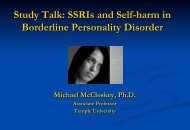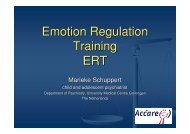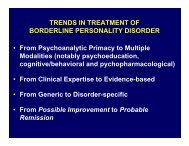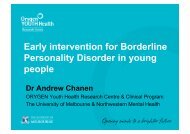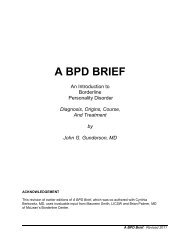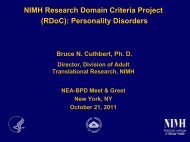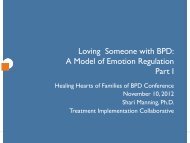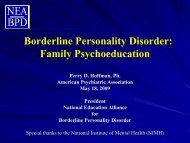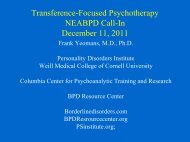Social Functioning in Patients with BPD - Borderline Personality ...
Social Functioning in Patients with BPD - Borderline Personality ...
Social Functioning in Patients with BPD - Borderline Personality ...
Create successful ePaper yourself
Turn your PDF publications into a flip-book with our unique Google optimized e-Paper software.
<strong>Social</strong> <strong>Function<strong>in</strong>g</strong> <strong>in</strong> <strong>Patients</strong> <strong>with</strong><br />
<strong>BPD</strong><br />
I am the most<br />
foolish idiot<br />
No! the most<br />
foolish idiot<br />
is me!!<br />
No,<br />
it`s me<br />
Mar$n Bohus, CIMH Mannheim
No conflict of <strong>in</strong>terest
Age at first psychiatric admission of <br />
pa4ents <strong>with</strong> <strong>BPD</strong> <strong>in</strong> Germany <br />
Mannheim-‐Study: 367 adult pa4ents <br />
BPS Patient<strong>in</strong>nen<br />
10<br />
Prozent<br />
9<br />
8<br />
7<br />
6<br />
5<br />
4<br />
3<br />
2<br />
1<br />
0<br />
1 3 5 7 9 11 13 15 17 19 21 23 25 27 29 31 33 35 37 39 41<br />
Alter bei erster psychiatirscher Behandlung<br />
Bohus, Kle<strong>in</strong>dienst et al., <strong>in</strong> prep.
Hospitalisa4on for <strong>in</strong>ten4onal self-‐harm <br />
<strong>in</strong> 2002/03 <strong>in</strong> New Zealand <br />
Life-‐cycle age groups
Age at Parasuicide Markers<br />
Age<br />
50<br />
45<br />
40<br />
35<br />
30<br />
25<br />
20<br />
15<br />
10<br />
5<br />
0<br />
Age at Assessment<br />
Age at Most Severe Parasuicide<br />
Subjects<br />
Age at First Parasuicide<br />
(L<strong>in</strong>ehan Suicide Workshop)
Non-‐Suicidal Self-‐Injury <strong>in</strong> German Adolescents: <br />
Heidelberg School Study (Brunner et al., 2007) <br />
Did you <strong>in</strong>jure yourself <strong>in</strong>ten$onally <strong>with</strong><strong>in</strong> the last <br />
year (cuAng; burn<strong>in</strong>g; etc) <br />
n=5522; age= 15 <br />
boys <br />
girls <br />
never 89.9% 80.1% <br />
1-‐3x year 8.0% 14.0% <br />
>3x year 2.1% 5.9%
Bully<strong>in</strong>g vic4misa4on and risk of self harm <strong>in</strong> <br />
early adolescence: longitud<strong>in</strong>al cohort study <br />
Fisher et al., BMJ 2012;344:e2683 doi: 10.1136/bmj.e2683 (Published 26 April 2012) <br />
• Prospek$ve Study <strong>in</strong>cl. 1116 tw<strong>in</strong>s <br />
• 5; 7; 9; 12 <br />
• Self-‐harm at the age of 12: 3% <br />
• „Frequent bully<strong>in</strong>g: 56% <br />
• Controlled for: Emo$onal <br />
Instability; Conduct Disorders; IQ; <br />
<strong>Social</strong> background <br />
• <strong>Social</strong> vicitmized show 5 $mes <br />
<strong>in</strong>creased risc for cuAng! <br />
• NSSI correlates <strong>with</strong> suicide <br />
adempts <strong>in</strong> the family, abuse and <br />
axis I disorders <strong>in</strong> the family
Adolescent borderl<strong>in</strong>e symptoms <strong>in</strong> the <br />
community: Prognosis for func4on<strong>in</strong>g over 20 <br />
years: G. W<strong>in</strong>ograd et al., 2008 <br />
– Prospec$ve Cohort Analysis n= 748: age: 14; 22; 33; <br />
– Diagnosis: PDQ (parent and youth report); SKID II <br />
– <strong>BPD</strong>-‐diagnosis 30 adolescents <br />
– <strong>BPD</strong> // social func$on// life sa$sfac$on
Adolescent borderl<strong>in</strong>e symptoms <strong>in</strong> the <br />
community: Prognosis for func4on<strong>in</strong>g over 20 years: G. <br />
W<strong>in</strong>ograd et al., 2008
Adolescent borderl<strong>in</strong>e symptoms <strong>in</strong> the <br />
community: Prognosis for func4on<strong>in</strong>g over 20 <br />
years: G. W<strong>in</strong>ograd et al., 2008 <br />
• <strong>BPD</strong> at mean age 13.7 <br />
were related to <br />
– Lower level of educa$on <br />
– Occupa$onal ada<strong>in</strong>ment <br />
– Roman$c partners <br />
<strong>in</strong>volvement <br />
– Ada<strong>in</strong>ment of <br />
developmental <br />
milestones
Employment – Status <br />
• Lofgren et al.; American J. Psych. 1991: <br />
– Follow up of 19 Adolescents <strong>with</strong> <strong>BPD</strong> ajer 29 years: only <br />
25% reported school-‐leaf<strong>in</strong>g qualifica$on or job
Mannheim Study: Employment of <strong>BPD</strong><br />
Arbeitsverträge <br />
Arbeitslos <br />
χ 2 =387.03,<br />
df=2, p
Borderl<strong>in</strong>e-‐Störung <br />
10-‐Jahre Remissionsraten (Zanar<strong>in</strong>i et al., 2010) <br />
100% <br />
90% <br />
80% <br />
70% <br />
60% <br />
50% <br />
40% <br />
30% <br />
20% <br />
10% <br />
0% <br />
93% <br />
30% <br />
86% <br />
15% <br />
50% <br />
34% <br />
N= 275<br />
Only 15% of the clients aba<strong>in</strong> stable psychosocial recovery
Established Psychosocial Treatments <br />
18 months: MBT vs. SCM <br />
Bateman & Fonagy, 2009 <br />
3 months: DBT-‐PTSD vs. TAU <br />
Bohus et al., 2012 <br />
GAF <br />
GAF <br />
12 months: TFP vs. TAU <br />
Doer<strong>in</strong>g et al., 2011 <br />
GAF
Established Psychosocial Treatments <br />
12 months: DBT vs. GPM <br />
McMa<strong>in</strong> et al., 2009 <br />
3 years: SFT vs. TFP <br />
Giessen-‐Blo et al., 2006 <br />
EQ-‐5D <br />
EQ-‐5D
Global Assessment of <strong>Function<strong>in</strong>g</strong><br />
80<br />
75<br />
70<br />
65<br />
60<br />
55<br />
PDP<br />
DBT<br />
50<br />
45<br />
40<br />
Pre 3 Months 6 Months 9 Months 12 Months<br />
Pistorello, FruzzeA et al., 2012; JCCP
Established psychosocial treatments do <br />
not seem to be highly appropriate for <br />
improvement of social func$on<strong>in</strong>g <strong>in</strong> <strong>BPD</strong>
Borderl<strong>in</strong>e Psychopathology <br />
Emo4on <br />
Dysregula4on <br />
Iden4ty Disturbance <br />
<strong>Social</strong> Interac4on <br />
Problems
<strong>Social</strong> <strong>in</strong>forma$on process<strong>in</strong>g model <br />
(adapted from Crick and Dodge 1994, Lemerise and Arsenio 2000, <br />
and Bugental, 2000) <br />
Database (schemas, <br />
knowledge, rules) <br />
Emo$on process<strong>in</strong>g <br />
Percep$on <br />
of social <br />
s$muli <br />
Inter-preta$on<br />
<br />
Match<strong>in</strong>g <br />
<strong>with</strong> <strong>in</strong>di-vidual<br />
goals <br />
Behavior <br />
plan <br />
An$cipa$on <br />
of conse-quences<br />
<br />
Behavior <br />
Evalua$on <br />
of <br />
behavior <br />
Time
<strong>Social</strong> <strong>in</strong>forma$on process<strong>in</strong>g model <br />
(adapted by M. Bohus from Crick and Dodge 1994, Lemerise and Arsenio 2000; D. Bugental 2000 ) <br />
Database (schemas, <br />
knowledge, rules) <br />
Emo$on process<strong>in</strong>g <br />
Percep$on of <br />
social s$muli <br />
Interpre-ta$on<br />
<br />
Match<strong>in</strong>g <br />
<strong>with</strong> <br />
<strong>in</strong>dividual <br />
goals <br />
Behavior <br />
plan <br />
An$cipa$on <br />
of <br />
consequences <br />
Behavior <br />
Evalua$on <br />
of Behavior <br />
Trust and Care <br />
to Protectors and <br />
Protegees <br />
Coopera$on <br />
Group <br />
Cohesion <br />
Hierarchical <br />
Structures <br />
Ma$ng
<strong>Social</strong> <strong>in</strong>forma$on process<strong>in</strong>g model <br />
(adapted by M. Bohus from Crick and Dodge 1994, Lemerise and Arsenio 2000; D. Bugental 2000 ) <br />
Database (schemas, <br />
knowledge, rules) <br />
Emo$on process<strong>in</strong>g <br />
Percep$on of <br />
social s$muli <br />
Interpre-ta$on<br />
<br />
Match<strong>in</strong>g <br />
<strong>with</strong> <br />
<strong>in</strong>dividual <br />
goals <br />
Behavior <br />
plan <br />
An$cipa$on <br />
of <br />
consequences <br />
Behavior <br />
Evalua$on <br />
of Behavior <br />
Trust and Care <br />
to Protectors and <br />
Protegees <br />
Coopera$on <br />
Group <br />
Cohesion <br />
Hierarchical <br />
Structures <br />
Ma$ng
<strong>Social</strong> <strong>in</strong>forma$on process<strong>in</strong>g model <br />
(adapted by M. Bohus from Crick and Dodge 1994, Lemerise and Arsenio 2000; D. Bugental 2000 ) <br />
Database (schemas, <br />
knowledge, rules) <br />
Emo$on process<strong>in</strong>g <br />
Percep$on of <br />
social s$muli <br />
Interpre-ta$on<br />
<br />
Match<strong>in</strong>g <br />
<strong>with</strong> <br />
<strong>in</strong>dividual <br />
goals <br />
Behavior <br />
plan <br />
An$cipa$on <br />
of <br />
consequences <br />
Behavior <br />
Evalua$on <br />
of Behavior <br />
Trust and Care <br />
to Protectors and <br />
Protegees <br />
Coopera$on <br />
Group <br />
Cohesion <br />
Hierarchical <br />
Structures <br />
Ma$ng
<strong>Social</strong> <strong>in</strong>forma$on process<strong>in</strong>g model <br />
(adapted by M. Bohus from Crick and Dodge 1994, Lemerise and Arsenio 2000; D. Bugental 2000 ) <br />
Database (schemas, <br />
knowledge, rules) <br />
Emo$on process<strong>in</strong>g <br />
Percep$on of <br />
social s$muli <br />
Interpre-ta$on<br />
<br />
Match<strong>in</strong>g <br />
<strong>with</strong> <br />
<strong>in</strong>dividual <br />
goals <br />
Behavior <br />
plan <br />
An$cipa$on <br />
of <br />
consequences <br />
Behavior <br />
Evalua$on <br />
of Behavior <br />
Trust and Care <br />
to Protectors and <br />
Protegees <br />
Coopera$on <br />
Group <br />
Cohesion <br />
Hierarchical <br />
Structures <br />
Ma$ng
<strong>Social</strong> <strong>in</strong>forma$on process<strong>in</strong>g model <br />
(adapted by M. Bohus from Crick and Dodge 1994, Lemerise and Arsenio 2000; D. Bugental 2000 ) <br />
Database (schemas, <br />
knowledge, rules) <br />
Emo$on process<strong>in</strong>g <br />
Percep$on of <br />
social s$muli <br />
Interpre-ta$on<br />
<br />
Match<strong>in</strong>g <br />
<strong>with</strong> <br />
<strong>in</strong>dividual <br />
goals <br />
Behavior <br />
plan <br />
An$cipa$on <br />
of <br />
consequences <br />
Behavior <br />
Evalua$on <br />
of Behavior <br />
Trust and Care <br />
to Protectors and <br />
Protegees <br />
Coopera$on <br />
Group <br />
Cohesion <br />
Hierarchical <br />
Structures <br />
Ma$ng
<strong>Social</strong> <strong>in</strong>forma$on process<strong>in</strong>g model <br />
(adapted by M. Bohus from Crick and Dodge 1994, Lemerise and Arsenio 2000; D. Bugental 2000 ) <br />
Database (schemas, <br />
knowledge, rules) <br />
Emo$on process<strong>in</strong>g <br />
Percep$on of <br />
social s$muli <br />
Interpre-ta$on<br />
<br />
Match<strong>in</strong>g <br />
<strong>with</strong> <br />
<strong>in</strong>dividual <br />
goals <br />
Behavior <br />
plan <br />
An$cipa$on <br />
of <br />
consequences <br />
Behavior <br />
Evalua$on <br />
of Behavior <br />
Trust and Care <br />
to Protectors and <br />
Protegees <br />
Coopera$on <br />
Group <br />
Cohesion <br />
Hierarchical <br />
Structures <br />
Ma$ng
<strong>Social</strong> <strong>in</strong>forma$on process<strong>in</strong>g model <br />
(adapted by M. Bohus from Crick and Dodge 1994, Lemerise and Arsenio 2000; D. Bugental 2000 ) <br />
Database (schemas, <br />
knowledge, rules) <br />
Emo$on process<strong>in</strong>g <br />
Percep$on of <br />
social s$muli <br />
Interpre-ta$on<br />
<br />
Match<strong>in</strong>g <br />
<strong>with</strong> <br />
<strong>in</strong>dividual <br />
goals <br />
Behavior <br />
plan <br />
An$cipa$on <br />
of <br />
consequences <br />
Behavior <br />
Evalua$on <br />
of Behavior <br />
Trust and Care <br />
to Protectors and <br />
Protegees <br />
Coopera$on <br />
Group <br />
Cohesion <br />
Hierarchical <br />
Structures <br />
Ma$ng
Outlook: Tra<strong>in</strong><strong>in</strong>g of social <br />
competence for <strong>BPD</strong> pa$ents (Bohus et al., <br />
<strong>in</strong> prepara+on) <br />
Prac$c<strong>in</strong>g … to adapt the algorithms of social life: (accord<strong>in</strong>g to D. Bugental) <br />
• use and recogni$on of social dom<strong>in</strong>ance (hierarchical power doma<strong>in</strong>); <br />
• how to tolerate and use hierarchical structures <br />
• iden$fica$on and ma<strong>in</strong>tenance of the l<strong>in</strong>es divid<strong>in</strong>g "us" and <br />
"them" (coali$onal group doma<strong>in</strong>); <br />
– -‐ how to get acqua<strong>in</strong>ted <strong>with</strong> and stay <strong>in</strong> groups <br />
• nego$a$on of matched benefits <strong>with</strong> func$onal equals (reciprocity <br />
doma<strong>in</strong>); <br />
• -‐ how to cooperate <strong>with</strong> colleagues <br />
• selec$on and protec$on of access to sexual partners (ma$ng doma<strong>in</strong>) <br />
• how to ma<strong>in</strong>ta<strong>in</strong> <strong>in</strong>$mate rela$onships <br />
• for proximity-‐ma<strong>in</strong>tenance <strong>with</strong><strong>in</strong> a protec$ve rela$onship (adachment <br />
doma<strong>in</strong>); <br />
– how to trust and take care of your fosters <br />
-‐ -‐
Thank you for your aben4on



